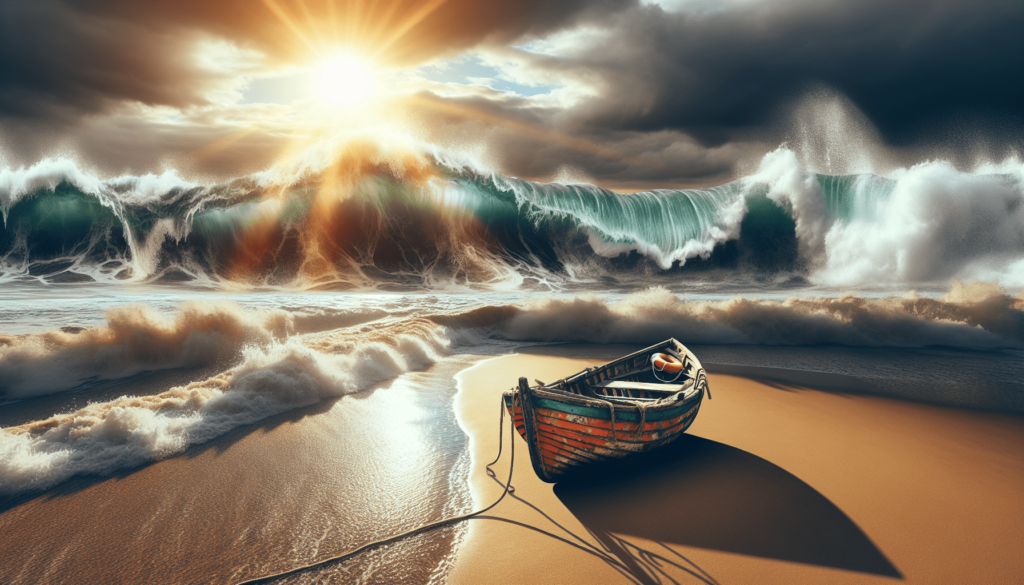Are you prepared for the unexpected when exploring the seashore? Whether you’re a beachcomber, a surfer, or simply enjoy a day by the ocean, being equipped with survival strategies is crucial in case of emergencies. In my blog, “The Survivalist Handbook,” I provide readers like you with valuable knowledge and techniques to thrive in any wilderness environment. From learning how to build a fire to finding food and water, my articles under the “Wilderness Survival” category will equip you with the essential skills needed to navigate through unforeseen challenges that may arise along the coast. Get ready to master the wilds and ensure your safety with my latest article, “Coastal Castaway: Survival Strategies for Seashore Emergencies.”
Understanding Seashore Emergencies
Importance of preparation
When it comes to seashore emergencies, preparation is key. Whether you’re planning a leisurely beach trip or embarking on an adventurous coastal expedition, having a solid survival plan can make all the difference. Understanding the potential risks and knowing how to react can save your life and the lives of those around you.
Common emergencies in seashore environments
Seashore environments can present a range of emergencies, each with its unique challenges. Some of the most common emergencies include getting caught in rip currents or undertows, encountering dangerous marine animals, suffering from jellyfish stings, and experiencing sunburn and dehydration. Being aware of these risks and knowing how to handle them is crucial for survival.
Impact of tides and weather conditions
Tides and weather conditions play a significant role in seashore emergencies. The changing tides can quickly transform a safe path into a treacherous one, leaving you stranded or vulnerable to the elements. Weather conditions such as strong winds, storms, and fog can also pose serious threats. Understanding how these factors affect the coastline and being prepared for their impact is essential for your safety.
Creating a Survival Plan
Assessing your surroundings
Before setting foot on the seashore, take some time to assess your surroundings. Familiarize yourself with the layout of the coastline, noting landmarks, potential hazards, and access points. Determine the safest areas where you can seek shelter or find help, if needed.
Identifying potential hazards
Being able to identify potential hazards is crucial in creating a survival plan. These hazards can vary depending on the location, but some common ones include rocky cliffs, unstable sand dunes, sharp coral, and dangerous marine animals. By recognizing these dangers in advance, you can take appropriate precautions and avoid unnecessary risks.
Creating a communication plan
In seashore emergencies, communication is vital for rescue and survival. Develop a communication plan that includes emergency contact numbers, the location of the nearest lifeguard station, and any available communication devices such as radios or cell phones. Inform someone you trust about your location and estimated return time. Regularly check in with them to provide updates on your situation.

Building Shelter
Importance of shelter in seashore emergencies
building a shelter is crucial in seashore emergencies as it provides protection from the elements and helps maintain body temperature. Whether you’re stranded on a remote beach or facing inclement weather, having a shelter can significantly increase your chances of survival.
Utilizing natural resources
Seashores offer a wealth of natural resources that can be utilized in building a shelter. Driftwood, rocks, and vegetation can all be used to construct a sturdy and functional structure. Take advantage of what the environment offers and adapt your shelter-building techniques accordingly.
Constructing temporary shelters
In seashore emergencies, time may be of the essence, and you may need to construct a temporary shelter quickly. Simple designs such as lean-tos, debris huts, or sand dune caves can provide immediate protection from the elements. Use available materials and focus on creating a shelter that is sturdy, waterproof, and wind-resistant.
Finding Food and Water
Identifying edible coastal plants and seaweeds
When stranded in a seashore emergency, finding food becomes a top priority. Familiarize yourself with edible coastal plants and seaweeds that are safe for consumption. Be cautious as not all coastal vegetation is edible, and some may be poisonous. Invest time in learning to recognize and properly identify edible species.
Fishing techniques for survival
Coastal waters are often filled with abundant marine life, making fishing a viable option for sourcing food. Learn basic fishing techniques such as handlining, netting, or spearfishing. Carry a compact fishing kit with essential supplies, including hooks, lines, and bait, to increase your chances of catching fish for sustenance.
Collecting and purifying water
Access to clean drinking water is essential for survival, especially in seashore emergencies where dehydration can quickly become a serious threat. Learn how to collect and purify water from the seashore environment. Make use of natural sources such as rainwater, streams, or natural springs, and employ purification methods such as boiling, filtering, or using water purification tablets.

Navigating the Coastline
Understanding coastal geography
Navigating the coastline can be challenging, especially in unfamiliar territory. Understanding coastal geography, including tidal patterns, sandbars, and rock formations, is crucial for safe navigation. Study maps, consult local guides, and pay attention to tide charts to plan your route and avoid getting stranded or swept away by the tides.
Using natural landmarks and celestial navigation
In the absence of modern navigation tools, natural landmarks and celestial cues can serve as reliable guides. Keep an eye out for distinctive landmarks along the coastline, such as rock formations or distinctive trees, that can help you determine your position. Understanding basic celestial navigation techniques, such as using the position of the sun or stars, can also assist in finding your bearings.
Building and using basic navigation tools
In addition to natural navigation aids, having basic tools can greatly assist you in navigating the coastline. Carry a compass, map, and GPS device if available. If you don’t have access to these tools, consider building simple tools from materials at hand, such as a makeshift compass using a magnetized needle and a leaf floating in water.
Signaling for Help
Importance of attracting attention
In a seashore emergency, attracting attention is critical for rescue. Be proactive in signaling for help, as it significantly increases the chances of being noticed by passing boats, aircraft, or other potential rescuers.
Creating visible signals
Create visible signals that can catch the attention of rescue teams. Use brightly colored materials, such as clothing or flags, to create a contrast against the natural environment. Arrange rocks, branches, or other objects in a way that stands out and can be easily seen from a distance.
Using sound signals
Sound signals can also be effective in attracting attention in seashore emergencies. Use a whistle, horn, or any available loud object to create a distinct and recognizable sound pattern. Consistent blasts or patterns, such as three short whistles or yells repeated in intervals, can indicate that you are in distress and in need of assistance.
Dealing with Common Coastal Threats
Handling marine animal encounters
Encountering marine animals can be intimidating and potentially dangerous. Stay calm and avoid sudden movements when faced with marine animals such as sharks, seals, or jellyfish. Educate yourself on their behaviors and follow recommended protocols for dealing with specific threats. Avoid feeding or approaching marine animals as it can provoke aggression.
Avoiding and treating jellyfish stings
Jellyfish stings can cause pain, swelling, and sometimes severe allergic reactions. Familiarize yourself with common jellyfish species in the area and learn how to identify their presence in the water. If stung, carefully remove any tentacles using tweezers or a similar tool. Rinse the affected area with saltwater, as fresh water can activate the stinging cells. Seek medical attention if symptoms persist or worsen.
Protecting yourself from sunburn and dehydration
Seashore emergencies often expose individuals to prolonged sun exposure, leading to sunburn and dehydration. Protect yourself by wearing light, breathable clothing, and applying sunscreen regularly. Stay hydrated by drinking plenty of water, even if you don’t feel thirsty. Consider seeking shade during the hottest parts of the day and taking regular breaks to cool down and rest.
Staying Safe in the Water
Understanding rip currents and undertows
Rip currents and undertows are powerful and potentially deadly ocean currents that can quickly sweep even strong swimmers away from the shore. Educate yourself on the signs of rip currents, such as darker or choppier water, and learn how to identify safe areas for swimming. If caught in a rip current, remember to float or swim parallel to the shore until you escape its pull.
Rescuing yourself and others in water emergencies
In a water emergency, knowing how to rescue yourself and others is crucial. If someone is in distress, use a flotation device or improvise one, such as a float made from clothing or wood, to provide support until help arrives. If you find yourself struggling in the water, stay calm and try to conserve energy by floating on your back and signaling for help.
Using flotation devices and improvised flotation aids
Having access to flotation devices, such as life jackets or floatation rings, significantly increases your chances of survival in the water. Always wear a life jacket when boating or participating in water activities. If you don’t have a life jacket, look for available items that can serve as improvised flotation aids, such as coolers, buckets, or empty plastic bottles.
Preparing a Coastal Survival Kit
Essential items to include in a survival kit
When venturing to seashore environments, it is essential to have a well-equipped survival kit. Some key items to include are a first aid kit, multi-tool, waterproof matches, emergency blanket, whistle, compass, flashlight, extra clothing, food rations, water purification tablets, and a portable water container. Tailor your survival kit to the specific needs of the environment and your planned activities.
Packing for maritime environments
When packing for maritime environments, consider the challenges and potential risks unique to these areas. Opt for lightweight, quick-drying clothing and footwear suitable for both land and water. Pack extra protection against the sun, such as a wide-brimmed hat and sunglasses. Use waterproof bags or containers to protect your supplies from moisture.
Personalizing your kit based on needs and location
While there are essential items that should be included in any survival kit, it is important to personalize your kit based on your specific needs and the location you will be visiting. For example, if you are venturing into an area with venomous marine animals, consider adding a snakebite kit or specialized first aid supplies. Tailoring your survival kit ensures you are prepared for the specific challenges you may face.
Conclusion
Importance of practicing survival skills
In seashore emergencies, having a comprehensive knowledge of survival skills can be lifesaving. But it’s not enough to simply read about these skills—you must actively practice and integrate them into your outdoor adventures. Regularly honing your survival skills will increase your confidence, efficiency, and ability to adapt in unforeseen situations.
Being proactive in seashore safety
Safety should always be a top priority when exploring seashore environments. Be proactive in assessing risks, understanding the local conditions, and staying informed about potential hazards specific to the area you will be visiting. Take preventive measures, such as wearing appropriate safety gear and practicing responsible outdoor behavior to minimize the likelihood of emergencies.
Staying informed and continuously learning
The key to staying safe in seashore emergencies is to remain informed and continuously expand your knowledge. Stay updated on current safety guidelines, local regulations, and any environmental changes that may affect the risks associated with seashore environments. Learn from experienced outdoor enthusiasts, attend wilderness survival workshops, and engage in online communities to stay connected and learn from others’ experiences.
By understanding seashore emergencies, creating a survival plan, building shelter, finding food and water, navigating the coastline, signaling for help, dealing with common coastal threats, staying safe in the water, preparing a survival kit, and consistently practicing survival skills, you can enhance your ability to stay safe and thrive in seashore environments. Remember, the more prepared you are, the more enjoyable and rewarding your coastal adventures will be. Stay safe and happy exploring!

